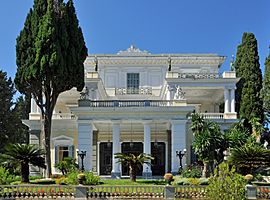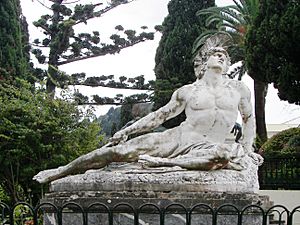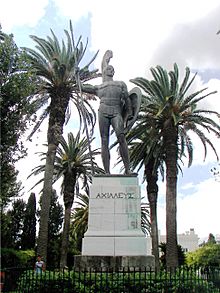Achilleion (Corfu) facts for kids
| Αχίλλειο/Αχίλλειον | |
 |
|
| Location | Αχιλλειοι 49084, Greece |
|---|---|
The Achilleion (Greek: Αχίλλειο) is a beautiful palace located on the Greek island of Corfu. It was built for Empress Elisabeth of Austria, who was also known as Sisi. She decided to build this summer palace as a peaceful escape after a very sad event in her life in 1889.
The palace is in a village called Gastouri, about ten kilometers south of Corfu city. From the palace, you can see amazing views of the city and the Ionian Sea. The palace was designed to look like an ancient Greek palace from myths. Its main theme is the Greek hero Achilles, which is where the name "Achilleion" comes from. Empress Elisabeth loved Greece, its language, and its culture, so she wanted a palace that showed her admiration.
Today, the Achilleion is a popular museum. It is managed by the Hellenic Tourism Development Company, which is part of the Greek National Tourism Organization.
Contents
History of the Achilleion Palace
Empress Elisabeth's Dream Palace
The land where the Achilleion stands was first owned by a philosopher and diplomat from Corfu named Petros Brailas-Armenis. It was known as "Villa Vraila." In 1888, Empress Elisabeth visited the spot and decided it was the perfect place for her own palace on Corfu.
The palace was designed by an Italian architect named Raffaele Caritto. It was built on a large area of land, about 200,000 square meters. Elisabeth's husband, Emperor Franz Josef of Austria, also owned some land nearby.
A German sculptor named Ernst Gustav Herter was asked to create statues inspired by Greek mythology. His famous sculpture, Dying Achilles, was made in Berlin in 1884. This statue is a main feature in the Achilleion Gardens.
The palace's design was meant to look like an ancient palace from the mythical land of Phaeacia. The building and its classical Greek statues show a love for ancient Greek ideas and a desire to escape from everyday life. That's why it was named after Achilles.
There are many paintings and statues of Achilles throughout the palace and gardens. They show different moments from the Trojan War, both heroic and sad. The building itself is in a style similar to ancient Roman houses found in Pompeii. Empress Elisabeth decorated it with many artworks.
She once wrote that she wanted "a palace worthy of Achilles, who despised all mortals and did not fear even the gods." Sisi used the Achilleion as a private retreat, a place to get away from the world and her past. She only invited her daughters, Archduchess Marie Valerie and Archduchess Gisela, and their husbands to visit her there. Her husband, Emperor Franz Joseph, never saw the palace because he did not like traveling by sea.
The gardens on top of the hill offer beautiful views of the green hills and valleys around, with the Ionian Sea in the background.
Empress Elisabeth visited Achilleion often until 1896. However, she later lost interest in the palace and even thought about selling it. Many of the items inside were moved back to Vienna. Sadly, in September 1898, Empress Elisabeth passed away due to an attack in Geneva.
Kaiser Wilhelm II's Summer Home
After Empress Elisabeth's passing, Achilleion was inherited by her daughter, Archduchess Gisela. However, she did not use it much. In 1907, the German Kaiser Wilhelm II bought the Achilleion and used it as his summer home.
During the Kaiser's visits, the Achilleion became an important place for European diplomacy. Many important meetings and discussions happened there. The Greek royal family, especially Wilhelm's sister Sophia of Prussia, who was the crown princess and later queen of Greece, often visited Corfu. The Kaiser also invited smart people like the German archaeologist Wilhelm Dörpfeld to his retreat.
The Emperor was very interested in the plants in the park. He hired Carl Ludwig Sprenger, a famous botanist, who lived at the palace for about three months each year. Wilhelm usually came to Achilleion during the Easter season because he enjoyed the local celebrations and cultural events. The German imperial family stayed on Corfu for about a month every year until World War I began in 1914.
Kaiser Wilhelm II added to the palace's theme by commissioning his own Achilles statue. The sculptor Johannes Götz created a large bronze sculpture that stands as a guardian in the gardens, facing north toward the city.
An archaeologist named Reinhard Kekulé von Stradonitz, who was also the Kaiser's advisor, helped decide where to place the huge statue. The Kaiser's tribute to Achilles was written at the statue's base: "To the Greatest Greek from the Greatest German." This inscription was later removed after World War II.
The Kaiser's statue shows Achilles in full hoplite (ancient Greek soldier) armor. It has detailed features, like a gorgon's head on the shield, which was believed to turn enemies to stone. This tall statue is surrounded by palm trees, making it look even more impressive. Kaiser Wilhelm continued to visit the palace until 1914, when World War I was declared. He also attended performances at the Municipal Theatre of Corfu while on vacation at the Achilleion.
While vacationing at Achilleion, the Kaiser was also involved in excavations at the site of the ancient Temple of Artemis in Corfu. He also removed a statue of the German poet Heinrich Heine that Empress Elisabeth had placed at Achilleion.
Achilleion During the World Wars
During World War I, the Achilleion was used as a military hospital by French and Serbian soldiers. After World War I, in 1919, it became the property of the Greek state. This happened as part of the Treaty of Versailles and the agreements for war damages.
From about 1921 to 1924, the palace housed an orphanage. It provided a home for Armenian orphans who had come from Constantinople. In the years between the two world wars, the Achilleion property was used for various government activities. Some of its artifacts were even sold off.
During World War II, the Axis powers used the Achilleion as their military headquarters. After the war, the Achilleion came under the management of the Hellenic Tourist Organisation (HTO).
Later Uses of the Palace
In 1962, the Achilleion was rented to a private company. This company turned the upper level of the palace into a casino and the lower grounds into a museum. In 1983, the rental agreement ended, and the palace management was returned to the HTO.
Important Meetings at Achilleion
The Achilleion has also been used for important European meetings. In September 1979, twelve historians from the United States, the United Kingdom, and Germany met there. They discussed Kaiser Wilhelm's character and his role in German politics. This conference was held in what used to be the Kaiser's bedroom.
More recently, the Achilleion has regained its status as a center for European diplomacy. It was used for the European summit in 1994. In 2003, it hosted a meeting of European ministers for Agriculture. Today, it mainly operates as a museum, while the casino function has moved to the Corfu Hilton.
Achilleion in Movies
The Achilleion palace has even appeared in movies! The casino scene in the James Bond film For Your Eyes Only, released in 1981, was filmed at the Achilleion.
Images for kids
See also
 In Spanish: Achilleion para niños
In Spanish: Achilleion para niños










